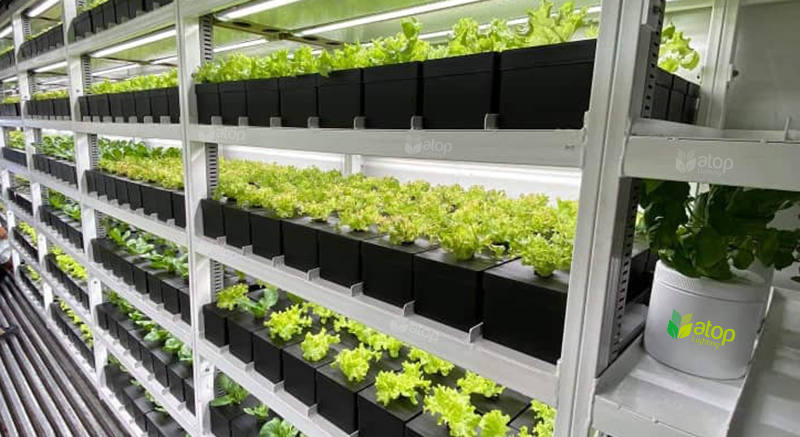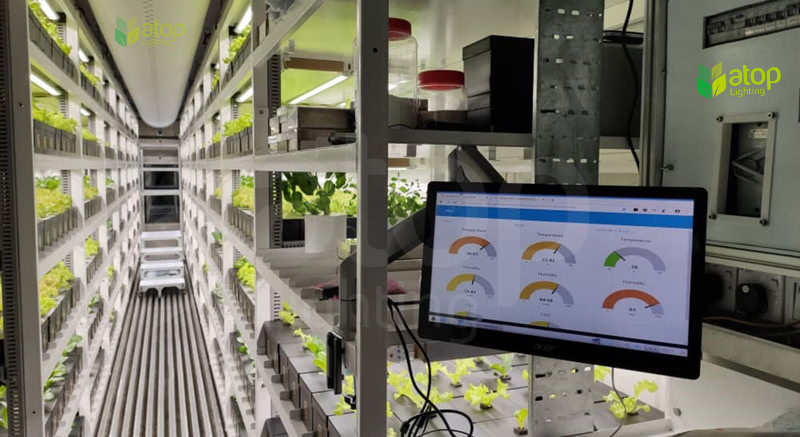Benefits and Challenges of Growing Leafy Greens with Vertical Farming
It is well known that we are facing rapidly increased population and serious climate change, which may cause food shortage. Vertical farming is one of the solutions to feed more people with fewer lands and space. It is a soil-less cultivation method that growing crops vertically through stacked layers. Vertical farming usually applies CEA (Controlled Environment Agriculture) technique to optimize the growing environment for crops. Factors such as temperature, nutrient, and water are carefully controlled in vertical farming. In theory, vertical farming is able to grow all crops. The five main grown crops are leafy greens, herbs, microgreens, flower, and tomatoes, of which leafy greens are the most planted. This post would like to talk about the benefits and challenges of growing leafy greens with vertical farming.

Benefits
-
Higher resistance to climate change
Conventional cultivation grows leafy greens in open fields. Leafy greens grow up with the help of natural light, rain, and soil. However, the more and more serious climate change could be a threat to the growth of leafy greens. The uncertain and extreme weather may even kill the leafy greens. In contrast, leafy greens are grown indoor with vertical farming. They are protected from climate change, such as floods, droughts, and heavy snow. Moreover, environment factors like water, nutrient, and lighting are provided in appropriate amounts. Because of the higher resistant to climate change in vertical farming, leafy greens is able to gain safer and more stable growing environment, conducing to robust and healthy plants.
-
Less requirement of lands and spaces
Rapid urbanization has swallowed up the amount of arable lands. Conventional leafy greens cultivation highly relies on arable lands. How to feed tremendous population with limited arable lands is a significant problem all over the world. One of the main benefits of vertical farming is the less requirement of lands and spaces. Vertical farming is free of soil. Therefore, arable land is needless for vertical farming. Furthermore, it can be carried out at almost any places. Generally, a vertical farm is located in abandoned buildings or shipping-container, which reach the full usage of wasted space. Since leafy greens are grown in the stacked layers vertically, vertical farming grows more plants than conventional cultivation in the same areas. In other words, less spaces are needed to plant the same number of leafy greens with vertical farming.
-
Vertical farming grows leafy greens effectively
Leafy greens are easy to grow with vertical farming. Since most of leafy greens do not grow tall, they can be planted with the stacked layers upwards. This allows growers maximize planting quality in less space. Vertical farming relies on artificial light due to the totally indoor environment. The low growing leafy greens makes LED grow lights can be placed near to the canopy of stacked layers without burning the plants. It also let the artificial light shines the leafy greens more evenly without shading the lower leaves. With sufficient lighting, leafy greens reach efficient growing. What’s more, leafy greens often have short growing cycle around 2-4 weeks, which means growers can harvest them in fewer time. Some leafy greens like lettuce can renew their leaves. The low growing height and fast turnaround time of leafy greens make them ideal for vertical farming.
-
Achieve higher yield and year-round production
The optimal growing environment and the wide spread of LED grow lights conduce to the higher yield and year-round production of leafy greens. The green, red, far-red and blue light spectra have different effects on root formation and leaves growth. White LED grow lights offer a full spectrum to mimic natural light, providing plants with a balanced spectrum of lights for plants to promote growth and improve yield and quality. The lighting enables year-round production in colder territories, getting plants to market early. Growers would have the harvest forward and earn more. With proper lighting, temperature, nutrition and growing environment, vertical farming can yield over 10 times than the traditional cultivation. The highly controlled environment reduce the risk of pest and resist natural disaster, ensuring the premium quality of crops.
Challenges
-
Higher energy consumption
Although less water and transportation cost are used in vertical farming, there still high consumption in electricity. As we all know, LED lights are able to save about 30% energy consumption compared to conventional lights. But in a vertical farm, a huge number of LED lights are needed for large scale cultivation. They are often kept on in a long period during a day. Thus, total energy cost is still higher than traditional cultivation. Apart from lighting energy cost, nutrition supply and other auxiliary operation equipment also consume massive electricity for uninterrupted working to keep leafy greens growing.

-
Require precise management
Vertical farming usually apply CEA techniques to optimize the growing environment for crops. To achieve well controlled environment, sensors and controls are added to vertical farming. Automation and mechanization make it easier to control the water, temperature, humidity, nutrition, lights, etc. Monitor sensors collect data and help growers analysis and adjust relevant parameters more conveniently. After reaching specific optimal conditions, leafy greens grow in high quality and production. But controlling the environment is also a problem for vertical farming. Sensors, controls, and software are of high expense. All the parameters should be adjusted precisely. Growers and workers should have adequate knowledge about the needs of plant and management of vertical farming environment. Otherwise, poor environment will stunt the growth of leafy greens or even kill the plants.
-
Difficult to achieve profitability
Vertical farming is appealing to most growers as it seems profitable for growing leafy greens. But the truth is that vertical farming is difficult to achieve profitability. It was reported that only about 50% of them are profitable. In addition, more than 5 years operation was needed to gain profits. Initiate capital, electricity cost, labor cost of vertical farming are much higher than conventional cultivation. Additional machines and equipment are also expensive. The return of investment should be calculated and considered. If the leaf greens produced by vertical farms cannot target the marketable production and competitive price, it is nearly impossible to reap profits.
Although growing leafy greens with vertical farming is not easy to realize profitability, needs of fresh leafy greens is always be there. Increasingly advanced technologies also benefit the development of vertical farming. The future of growing leafy greens with vertical farming is bright and positive.
Conclusion
Growing leafy greens with vertical farming has a higher resistance to climate change as leafy greens are grown indoor. It also saves land and spaces because leafy greens are grown in the staked layers vertically. Additionally, most leafy greens grow short and small with a quick turnover time. These features make vertical farming ideal for growing leafy greens. The main benefit of growing leafy greens vertical farming is to achieve higher yields and year-round production. Although vertical farming is beneficial for growing leafy greens, challenges remain. To realize an optimal growing environment for leafy greens, equipment, sensors, and controls consume a large amount of electricity and require precise management. Machines, labor, and maintenance are of high cost as well. The tremendous cost and long-time return of investment conduce the difficult profitability. Technology is advancing all the time, challenges of vertical farming will be solved shortly, achieving profitable, consistent quality, and high yield leafy green production.

